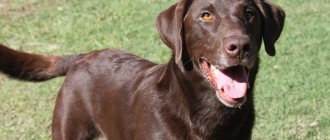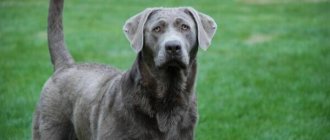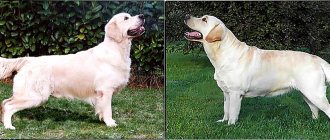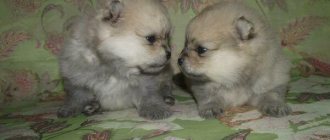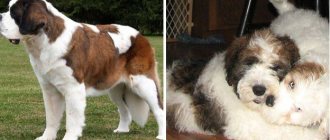The Labrador Retriever is a breed of dog that was originally bred as a hunting dog. Today, Labradors are widely used as guide dogs and companions. The animal originates from the island of Newfoundland, Canada.
White Labradors begin their history in the 19th century.
At that time, in order to obtain assistants in the hunting field, it was decided to cross breeds such as the small Newfoundland, the curly-haired retriever, the English foxhound and the setter. As a result, the Labrador Retriever appeared.
The first representatives were completely black, but as Labrador retrievers continued to be crossed with their brothers, white puppies appeared.
The animals were brought to Russia only in the 1990s, but almost immediately won the love of the inhabitants of this country.
Marriage or breed and what it looks like in the photo
The first breed standard was established back in 1887 by the English Kennel Club, which recognized only black color . However, at the beginning of the 20th century, fawn and chocolate colors became acceptable.
White Labrador Retrievers are never recognized by any kennel club, so this color is considered a defect.
Expert opinion
Kozhevin Semyon Kirillovich
Expert dog handler.
“The white Labrador retriever is no different from its black or chocolate counterparts; all its character traits fully comply with the breed standards. This animal is perfect for adults who will be able to spend a lot of time with it, because if the pet is left alone, then you can expect a disaster - furniture will be chewed, equipment will be damaged. The animal gets along well with children and will even tolerate being ridden, but this point should be controlled, since the pet is very emotional and may be offended by such an attitude, which will lead to illness. Often suffers from dysplasia.”
History of the breed
The breed has been known since the beginning of the 18th century. To date, there is no reliable data on the crossing, as a result of which the Labrador breed was developed. There is only a version that the Newfoundland was crossed with another breed.
At the very beginning of their appearance, Labradors helped sailors in pulling nets ashore. However, the status of a Labrador’s assistant remains relevant to this day, and Labradors provide assistance to people in a variety of areas. This dog is famous for its reliability and resistance to any difficulties in life.
Personality Traits of a White Labrador
White Labrador Retrievers are very intelligent and quick-witted animals.
In this regard, they can even be compared with such well-known breeds as:
- beagle;
- fox terrier.
Labradors want to be useful, so they always listen to their owners. This is confirmed by numerous official ratings, where representatives of this breed occupy an honorable place in the top five in terms of intelligence and aptitude for training.
White Labrador Retrievers are very cheerful and playful, making them excellent companions for children . They are friendly towards strangers and other animals.
Despite the friendliness of white Labrador retrievers, they should not be housed in the same room as parrots or other birds, as this will trigger the dog’s hunting instinct.
Labrador retrievers are dogs created for living in a family; they literally become an integral part of it..
These animals cannot imagine their life without communication, but at the same time they subtly sense the mood of their owners, never getting bored. They are able to adapt not only to the mood of the owner, but even to his habits.
Due to the high intellectual abilities of the white Labrador retriever, it is quite possible to teach him the following actions:
- bring slippers;
- turn on the light;
- open or close doors.
Training
The white Labrador is very intelligent and therefore easy to train. It is very important for the owner to take a leadership position. To do this, teach your Labrador to share food with you. During training, be patient; Labradors take a long time to learn commands, but remember them for life.
Conduct training daily, give tasks in a calm, commanding tone. You cannot beat, humiliate, or shout at dogs. With proper upbringing, you will not only have a beloved pet, but also a faithful companion.
Advantages and disadvantages
The Labrador Retriever has the following advantages::
- attractive appearance;
- friendliness, kindness to other animals and people;
- good receptivity of teams;
- ease of care and education;
- owner-oriented.
Among the disadvantages of the breed are the following::
- excessive kindness, which is why the animal cannot be a good guard;
- love of water, which is why the pet often runs through muddy puddles;
- likes to dig through garbage, often brings trophies to the owner in the form of dead rats and birds;
- can chew on absolutely any objects, which is why furniture often suffers;
- snore.
Varieties of genotypes
The table below lists the possible varieties of genotype and phenotype (genotype is a set of genes, phenotype is appearance).
| Gene set | Color |
| EEBB | Black |
| EEBb | Black |
| EEbb | Brown |
| EeeBB | Black |
| EeBb | Black |
| Eebb | Brown |
| eeBB | Yellow |
| eeBb | Yellow |
| eebb | Yellow |
Breed genetics more clearly
Dimensions, weight and other distinctive features
White Labrador Retrievers have a number of features:
| Factor | Males | Bitches |
| Height (cm) | 56-57 | 54-56 |
| Weight, kg) | 27-40 | 27-35 |
| Body | Wide chest, rounded ribs, short wide loin. | |
| Head | Medium size. The transition from the forehead to the muzzle is clearly defined. | |
| Wool | Smooth, short, thick and even. | |
| Paws | Rounded, have well-developed pads | |
| Ears | Triangular, close to the head, light. | |
| Eyes | From hazel to brown. | |
Dossier
Height of an adult dog: 56-58 cm. Weight: male – 27-36 kg, female – 25-32 kg. Characteristic color: solid white. Wool length: up to 5 cm. Life expectancy: 10-13 years. Advantages of the breed : do not show aggression, love to play outside, can be trained quickly. Difficulties of the breed: A bored Labrador can damage property. They require attention and care. White Labrador price: $160-800. Classification: large, hunting, rescue.
Possible shades
White Labrador Retrievers come in several shades:
- White with black pigment . Occasionally, with age, a “golden coating” appears.
- Cream . There is a fairly light color; along the spine and ears there are slightly darkened areas of fur.
- Red Fox. Somewhat reminiscent of fox fur.
Three colors of Labrador
According to the standard, Labradors come in three colors:
- Black;
- Chocolate;
- Fawn.
Black coloring is considered traditional and is complemented by brown or hazel eyes and dark earlobes. A dog with such fur shines and shimmers in the sun. The blackness can be diluted with a white spot on the chest or tan marks.
Chocolate Labradors became popular thanks to the American President, who was publicly presented with a puppy with this color.
The “boom” of dogs with brown fur has not yet passed, and more and more people want to have such a spectacular pet.
The combination of chocolate color with hazel or yellow eyes is also interesting. However, “rich” chocolate must be properly cared for: do not keep dogs in the sun for long and feed it with special vitamins.
Labradors with fawn coats come with golden, light cream, red tint or brown pigmentation.
Life expectancy, and what diseases are they susceptible to?
The lifespan of a white Labrador retriever is from 10 to 14 years .
Over the course of life, problems with excess weight may arise, which lead to the development of a number of chronic diseases and shorten the pet’s life expectancy.
Among the common diseases in Labradors, the following are noted::
- dysplasia of the hip or elbow joint;
- osteochondrosis – the joint in the area of the knees, shoulders and elbows is not formed correctly;
- cataracts, retinal detachment and other eye diseases;
- hypothyroidism – deficiency of thyroid hormones;
- allergic reactions manifested by damage to the skin (eczema, dermatitis);
- ichthyosis (in this breed it occurs without damage to the immune system) - profuse dandruff;
- nasal parakeratosis – crusts and cracks on the nose.
Black
These dogs usually have dark brown eyes and black pigment on the nose, around the mouth and around the eyes. They have a clean, smooth and shiny coat. They are especially popular among hunters, but can also be used for exhibition. Aging black dogs are easier to identify than others because the gray patches around the muzzle are clearly visible against their coat.
Basic rules of care
Despite their short coat, Labrador Retrievers are regularly groomed using a rubber brush. The animal must be accustomed to this procedure from an early age, then the animal will simply adore it.
Thanks to this combing, the dog not only gets rid of excess hair, but also improves blood circulation and stimulates the growth of new hair..
Representatives of the breed are allowed to be bathed frequently. It is necessary to examine the animal’s ears and teeth every few weeks. If there is contamination, the ears are cleaned with a cotton swab previously soaked in hydrogen peroxide.
NOTE!
Once every 2-3 months, the pet’s teeth are cleaned to remove stones. If serious problems with gums or teeth are noticeable, then contact a veterinarian.
Caring for a Labrador Retriever also involves trimming its nails regularly. With frequent walks on asphalt, the claws wear down on their own.
For feeding , choose one of the options :
- store feed;
- natural food.
If the choice fell on natural food, then it is important to calculate its quantity, for example, for each kilogram of animal, 20 grams of meat are given at a time.
Products containing meat constitute 50% of the daily diet . Buckwheat, wheat and rice porridge are cooked for the animal.
Labrador: maintenance and care
In order for a dog to live a long time and delight all family members with its cheerful disposition, it needs to be provided with proper care. For a loving owner this will not be difficult. But to avoid problems, you need to accustom your Labrador puppy to hygiene procedures as soon as he appears in the house. With proper care, life expectancy will be at least 12 years.
These animals are unpretentious and can be kept in a city apartment. The main condition is to ensure sufficient physical activity. You need to walk with your pet for at least 3-4 hours a day, preferably so that it moves actively. These dogs love water very much, so if possible, you need to take them to a river or lake.
Puppy with kitten
The rules of care are no more complicated than for other pets. After a walk, you need to wipe your paws, trim your nails regularly, and examine your eyes and teeth. You need to be more careful with your ears - they are droopy and often get dirty, which can lead to inflammatory diseases.
A difficulty for some owners is the long-term shedding of their pet. He has a lot of undercoat, and by the time he changes everything, there will be fur all over the house. To avoid this, you need to thoroughly comb your pet every day at this time. The rest of the time, it is enough to comb it once a week.
Thanks to its special properties, the pet's fur cleans itself. Therefore, it does not need frequent washing. Most veterinarians, when asked how long to bathe a pet, answer that 2-3 times a year is enough. The exception is the fawn colored dog. Light fur quickly becomes dirty, and dark spots form around the eyes and ears, as well as on the paws.
Feeding
It is best to feed your pet dry food. If you buy super-premium or holistic options, it will be provided with all the necessary nutrients. Dry food is balanced; usually, this feeding does not require additional vitamin supplements. The main thing is to correctly calculate the amount, since these animals are prone to obesity. It is better to consult a veterinarian, they have a good appetite and can overeat.
Puppy
When feeding natural food, it will be difficult to provide your pet with all the necessary substances. It is important to correctly create a diet, determine how many times he should eat and what portion. Many people are interested in whether it is possible to give a Labrador chicken and vegetables, this is allowed. Sweets are prohibited for him, especially chocolate, pasta, pastries, onions, potatoes, pork, raw fish, chicken bones.
Diseases
Labradors have several diseases that are more common than others. The most common is obesity. These dogs gain excess weight quickly, especially if you don’t watch their diet. To avoid this, you need to consult your veterinarian about how many hours a day your pet needs to run. It is usually recommended to walk for 2-4 hours.
Color black
Atopic dermatitis is common in these dogs. But this disease can also be kept under control by watching your diet. But diseases such as cataracts, osteochondrosis, hip dysplasia in a pet can be congenital.
For more information about what you need to buy for a Labrador puppy and how to provide him with good conditions, you can watch the video:
What do the puppies look like?
The appearance of Labrador Retriever puppies directly depends on their age.
For example, a 1-month-old puppy has the following characteristics :
- weight – from 3.4 to 3.8 kg;
- chest circumference – 37-38 cm;
- muzzle circumference – 17 cm;
- mouth girth – 9 cm;
- height at withers – from 23 to 23.5 cm;
- head circumference – 27-28 cm;
- muzzle length – from 3.5 to 4 cm.
In terms of its physique, it is a small copy of an already adult pet.
Description of the breed
The photo of the Labrador Retriever shows that the breed is particularly strong and has a rather powerful build. The eyes of a Labrador are brightly defined. The paws are strong, the head is wide. The body shape resembles a square.
The Labrador's tail is not docked; it is quite dense and thick and is an extension of the back. The wool is medium length and waterproof.
The dog weighs on average from 30 to 40 centimeters, height at the withers reaches up to 55 centimeters. Due to its parameters, it may appear taller and larger than it actually is.
The Labrador is a single color. There are black, fawn and chocolate dogs.
What nickname to name a boy and a girl
Among the popular names for a white Labrador retriever boy are the following :
- Archie;
- Brook;
- Vico;
- Grego;
- Jam;
- Kevin;
- Leicester;
- Max;
- Nile;
- Oscar;
- Patrick;
- Roni;
- Sancho;
- Tito;
- Juan;
- Freddie;
- Shusan.
Popular nicknames for girls are::
- Athena;
- Beauty;
- Wendy;
- Grace;
- Dekla;
- Irma;
- Christie;
- Lana;
- Mimi;
- Nancy;
- Pixie;
- Chamomile;
- Sali;
- Tusya;
- Eileen;
- Floris;
- Shumka;
- Juno.
The influence of color on the character of a pet
Upon external examination, it may seem that a light, almost white or beige Labrador is more good-natured than a black one. In fact, coat color does not play a significant role, since it does not affect the dog’s temperament and habits.
These animals are distinguished by their intelligence and intelligence. Labradors are charming, which has contributed to the growth of their popularity. Personality is defined as friendly and reliable.
Labrador has a healthy psyche, calmness, and balance, so it often appears in families with children. A patient dog surprises with its lack of aggression; it is ready for games and endures pranks stoically. Without giving preference to anyone, the dog communicates with household members and senses their mood. Quickly finds contact with nearby animals. Alone he gets sad and starts to get bored.
Thanks to their naturally high level of intelligence, Labradors easily master the proposed rules and commands. They are loyal and obedient, so they are used as a rescuer, nanny, guide, and serve in the police. Dogs even help doctors socialize children with autism, Down syndrome or cerebral palsy.
The Labrador cannot cope only with the role of a bodyguard or watchman. His lack of anger prevents him from attacking anyone.
At home, the pet will always sympathize with the owner if he notices his depressed state. With proper upbringing, the dog becomes an attentive and loyal friend. He likes when everyone is together, so he expresses dissatisfaction when walking someone to school or work. Joyfully welcomes guests, participates in holidays and gatherings. Because of their character, Labradors are called angel dogs.
Training a small puppy eliminates cruelty. Physical punishment or yelling is unacceptable. An intelligent pet quickly understands requirements if rewarded with a kind word or treat. The difficulty lies in the dog’s desire to chew on any objects. But if you remove wires and shoes in a timely manner and gradually instill in him the prohibition, then an adult Labrador will lose the habit of spoiling things.
Snacks and food from the common table are contraindicated for dogs. The menu for dogs uses professional food that has a balanced composition. If the puppy has been accustomed to natural food, then it is prepared only from high-quality approved products.
The base is lean meat - beef, rabbit, turkey, chicken. Porridge, vegetables, herbs, berries, and fruits are included in the diet. Sea fish and eggs are given no more than twice in 7 days.
They note that a girl Labrador is more affectionate. She is very obedient and easily becomes attached to household members. During a walk, he will not run away to explore the territory, so the owner can do without a leash, except during periods of heat.
The male is curious. He needs to explore the surroundings and socialize with other dogs. In order not to create a dangerous situation for the pet, it is not allowed to roam freely.
Regardless of gender, the result of competent training is an intelligent dog, striking in obedience and good manners.
Expert opinion
Anna Abramenko
An avid dog lover. Experience in veterinary medicine since 2009.
Ask a Question
At home, the Labrador will happily bring his owner a hat or slippers. You can also trust him with more fragile things - a smartphone, glasses, which the dog takes with his teeth with care.
How to choose?
When choosing a white Labrador retriever puppy in a kennel, you need to pay attention to a number of points:
- It is better to purchase an animal from working lines. Thus, a person receives a guarantee of a stable psyche and good physical condition of the parents of the future pet.
- Availability of documents for timely vaccinations and absence of dysplasia in the puppy’s parents. Serious breeders test the condition of animals on the territory of European countries, where they travel with dogs to various exhibitions.
- If in a nursery Labradors are sitting in enclosures, then you should immediately turn around and leave, because these animals need constant communication, and such an attitude leads to mental disorders.
- When examining puppies, the bitch must be friendly and not interfere with this. At the beginning, a little barking is allowed, but the animal must quickly calm down, then it makes sense to talk about its normal mental state and choose puppies from this litter.
- From a good breeder you should expect a lot of questions, including not entirely decent ones, for example, “How much do you earn?” This indicates that the breeder cares about his pets and will not give them away to just anyone. But bad breeders, on the contrary, try in every possible way to praise their pets.
IMPORTANT!
Taking into account all these nuances, you can choose a physically healthy and mentally balanced puppy.
White Labrador retrievers can become true friends and faithful companions, the main thing is to devote at least a little time to them every day.
Genes responsible for the silver color of a dog
But that is not all. There is another pair of genes, D and d. These genes have the ability to suppress all other colors, albeit in a subtle way.
This leaves three more options:
- DD
- Dd
- dd
When two small dd genes come together, they "dilute" the Labrador's coat color.
Labrador with silver wool
If the dog is black, the coat will be a soft charcoal color; a yellow dog will have a paler, champagne-colored coat. For a chocolate cat, the result of this mixture will be silver wool. This color is not officially recognized, as there is debate about purebredness.
Recommendations for education and training
Training dogs of this breed can begin at an early age, starting as early as four to five months. However, this recommendation is relative and aims at early adaptation of the puppy to the social external environment.
However, even at the age of over two years, these dogs learn commands well and quickly remember them. The docile and calm nature of the Labrador breed is fully demonstrated here in the description of the standards, but this should not be abused. They are quite trainable, but they may not remember some commands right away. In this case, you have to show persistence, which in no case should be brought to the point of rigidity.
When training, it is important to be able to show patience - it will be needed when learning complex commands or those that the dog does not like.
Puppies and older Labradors usually perceive such activities as a game and readily get used to them. In order for your pet to better and faster understand what is required of him, it is advisable to give him a treat during classes for a well-completed task. By the way, they are ready to carry out the orders of the owner even for a good word - dogs of this breed love praise. Especially if it is expressed with warmth and not formally. By the way, you cannot turn such training sessions into a monotonous, everyday activity - the dog will quickly get tired and not obey well.
Features of feeding an adult Labrador
As an adult, a Labrador Retriever dog should be completely switched from dry food to food made from natural products, which, of course, is better for his health. This breed of animal is a hunting one, so the diet should be based on animal protein. In percentage terms, this looks like 50 to 60% meat or meat products to ensure the normal functioning of the dog for many years.
But this does not mean at all that you need to feed an adult Labrador only meat; it will be better if the rest is supplemented with porridge (about a third of the diet) and boiled vegetables. In addition, it would not be superfluous to include fish and fermented milk products in the diet of an adult dog, which will help keep the dog’s weight within the desired limit.
The dog's transition to natural food also includes the inclusion of special vitamins, which can be purchased in specialized pet stores.
An adult Labrador retriever should consume 500 grams per day. food in 2 doses, that is, 250 g. for each appointment. The main requirement of the feeding process for an adult Labrador is the exception of pampering your pet with smoked meats and sweets. And also the exclusion of feeding the dog with table scraps.
Unusual colors
In addition to those described above, there are species with unusual colors. These include Dudley, spotted and silver Labradors. The main difference between Dudley and the standard is the pinkish tip of the nose and light pigmentation of the gums and eyelids. Golden dudleys are most common, but they also come in black and cream. The eyes of these animals may even be green, which is unacceptable for the standard.
Spotted dogs are also considered an unacceptable deviation from the standard, although they look quite cute. But the silver Labrador, which is not included in the breed standard, is quite popular at the moment. Although it will not be possible to participate in exhibitions with him, many people want to buy a dog of this particular color. And demand, as you know, creates supply, so silver dogs can be purchased at a very high price. Although you will not be able to participate in dog shows with a pet of non-standard colors, this does not mean that such a dog will not become a loyal friend and family member. In addition, by purchasing an animal of an unusual color, you will spend much less money.
Similar article: What types of Labrador mixes exist in nature?
Labradors in England
The arrival of Labradors in England was the last clear fact in the history of these dogs. After this, researchers have only a mass of theories, the authenticity of which cannot be confirmed in any way.
Some are sure that the Labrador breed already looked like this when they lived in Newfoundland, long before moving to Foggy Albion.
At the end of the last century, the remains of dogs that died back in 2000 BC were found on the same island. The ancient descriptions that remain from the time of their first arrival in England are very similar to what archaeologists found on the island.
Genetics
Labrador color plays a key role in breeding pedigree dogs. There are established combinations of genes responsible for the color of Labradors, and a detailed study of the Labrador's pedigree allows one to avoid problems with the purity of the breed.
In genetics, the letters B and E indicate black coat color. These genes are both dominant. Chocolate and fawn colors are indicated by the letters b and e, and these are recessive genes. There are 9 different gene combinations in total. A puppy receives a pair of genes from each parent.
A black Labrador with the EEBB gene combination has only black dogs in its family. However, if you breed such a Labrador with a carrier of one of the recessive genes (fawn or chocolate), then there is a possibility that the puppies, upon reaching the age of an adult dog, will give birth to fawn or brown Labradors.
The birth of black puppies from fawn parents becomes a cause for surprise among inexperienced breeders. However, from a point of view, this situation is not at all surprising: a fawn Labrador, regardless of gender, can act as a carrier of the black color gene.
When visually assessing a dog, it is impossible to determine the combination of its genes responsible for the color of the animal. You can find out information about gene carriage only after the Labrador has produced offspring. You can also find out information about the Labrador’s closest generations of relatives from its pedigree, but this information is not enough to evaluate the entire pedigree of the pet.
Deviation from standard
Breeders advise against breeding dogs that do not meet the standard, so they are usually spayed or neutered. Puppies that do not meet the breed standard are spotted puppies and dudley puppies. Dudleys are retrievers with abnormal pigmentation.
They have a pink or coffee-colored tip of the nose, while the nose itself is also light brown. Their eyelids and gums are light, while the standard is dark. The main color is any – both black and golden.
Important! If you are getting a puppy for yourself, without showing it in competitions, then you can safely take such a baby, since a pink nose does not affect the dog’s health.
There are cases when black babies have white hairs. Later, recoloring occurs, the dog becomes charcoal in color, but is not suitable for breeding.
Cubs with white “socks” and spotted dogs also do not fall under the standard, which does not prevent them from remaining loyal and intelligent dogs. And you can buy such a puppy much cheaper
Unusual color at birth
Several cases have been recorded in the world and one of them was in England, a green Labrador was born. The newborn puppies of a pair of fawn retrievers had a greenish tint to their fur .
When studying this amazing fact, it turned out that a dog’s placenta contains a substance called biliverdin, which gives this color. But as it grows, the green color goes away and the puppy becomes creamy, just like its parents.
Nutrition. What to feed your Labrador?
Proper nutrition is the main component of your Labrador's health and activity.
If you prefer ready-made dry food, give preference to expensive and high-quality premium products. Stick to portions and number of meals.
The frequency of feedings depends on the age of your dog. The younger the puppy, the more often he needs to be fed:
- the first two months of life - six meals a day;
- 3 and 4 months feed 5 times a day;
- 5th and 6th months, reduce the number of meals to 4;
- puppies in the second half of their life usually eat 3 times a day;
- Dogs older than one year eat 2 times a day.
An adult Labrador should receive meat daily in the amount of 20 grams per 1 kg of its weight. There should be no more than 1-2 grams of fat per kilogram of weight. Porridge (carbohydrates) make up half the volume of meat.
If you prefer natural products, you should know about the benefits and features of all their types.
- Meat . Lean beef or lamb should be fed raw. Before this, it must be kept in the freezer for a day, and then scalded with boiling water. This will remove harmful microorganisms. Offer the meat in a finely chopped state, but not as minced meat due to poor digestibility.
- Offal . Kidneys, liver, udders can be given to Labradors from 6 months. Offer the product exclusively in boiled form.
- Dairy . Cottage cheese and kefir are well absorbed.
- Eggs . Give only by mixing with other products for better absorption. The norm is one egg per week.
- Fish . Give sea fish raw, and river fish boiled.
- Cereals . Rice, buckwheat, millet are useful. Combine porridge with vegetables.
- Vegetables . Zucchini, carrots, and cabbage, grated or stewed, are extremely healthy. Don't forget about greens - lettuce, parsley.
List of prohibited products:
- pork;
- milk;
- bones;
- semolina;
- barley grits;
- corn porridge;
- pearl barley;
- potato;
- peas;
- beans;
- sweets.
The temperature of the dish should be moderate. Hot and cold foods are not allowed.

